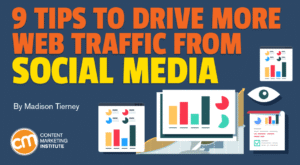In the digital era, having a website is only the first step toward building an online presence. To make an impact, you need visitors—real, engaged users who explore your content, products, or services. One of the most powerful tools to attract such visitors is social media. With billions of active users across platforms like Facebook, Instagram, LinkedIn, Twitter (X), and TikTok, social media offers a tremendous opportunity to drive traffic to your website—if done correctly.
In this blog post, we’ll explore effective strategies to drive traffic from social media to your website, regardless of your industry or niche.
1. Optimize Your Social Media Profiles
Your social media bio is the digital storefront for your brand. It’s often the first place people go to learn about you. Make sure your profiles are:
- Complete and professional
- Clearly explain who you are and what you offer
- Include a direct link to your website, preferably to a high-converting landing page
Use tools like Linktree or Beacons if you need to link to multiple pages. This is especially helpful for platforms like Instagram or TikTok, where you only get one clickable link.
2. Share Valuable, Click-Worthy Content
People don’t click on boring or overly promotional posts. To drive traffic, focus on content that provides real value. Think:
- How-to guides
- Tips and tricks
- Infographics
- Videos
- Free downloads or resources
Use strong calls to action (CTAs) like:
- “Read more on our blog”
- “Visit the link in bio”
- “Check out the full article on our website”
Your content should naturally lead people to want more—ideally from your site.
3. Tailor Content for Each Platform
Different social platforms serve different audiences and content formats. What works on LinkedIn might not work on Instagram. Here’s a quick rundown:
- Facebook: Great for detailed posts, events, and community building. Share blog links with engaging captions and images.
- Instagram: Visual-first. Use stories and reels to tease blog content, then direct viewers to the link in bio or use swipe-up links (if eligible).
- Twitter/X: Short, punchy updates. Share headlines with links and use relevant hashtags.
- LinkedIn: Ideal for B2B. Share insightful articles, whitepapers, or case studies with a professional tone.
- TikTok: Focus on short, engaging videos. Use a CTA in the video or caption that leads users to your profile link.
4. Use Hashtags Strategically
Hashtags increase the discoverability of your posts. When used effectively, they can bring in people who don’t already follow you.
Tips:
- Use relevant and specific hashtags, not just generic ones like #business
- Research trending or niche hashtags in your industry
- Don’t overdo it: 5–10 focused hashtags usually perform better than 30 random ones
Hashtags help surface your content to new audiences who may then visit your profile and click through to your site.
5. Leverage Stories, Reels & Live Video
Short-form and real-time content drives higher engagement and offers direct traffic opportunities.
- Instagram Stories: Add links (via stickers) that take users directly to your site.
- Facebook Live/Instagram Live: Talk about your content or products and include your website link in the comments or captions.
- Reels/TikToks: Showcase value in 15-60 seconds and tell users where to go for more info.
Engagement tends to be higher on these formats, giving you more chances to convert viewers into website visitors.
6. Collaborate with Influencers and Partners
Influencer marketing and partnerships can bring your content to new, relevant audiences.
- Micro-influencers (1k–100k followers) often have high engagement rates and niche communities.
- Partner with brands or creators who align with your audience and values.
- Ensure the influencer’s post includes a clear CTA and link to your site.
These collaborations can lead to spikes in traffic and long-term brand recognition.
7. Run Targeted Social Media Ads
While organic reach is important, social media ads can amplify your efforts.
- Use Facebook Ads, Instagram Ads, or LinkedIn Ads to target specific demographics or interests.
- Promote high-converting blog posts, product pages, or lead magnets.
- A/B test headlines, visuals, and CTAs to optimize click-through rates.
Ads are especially useful when launching a product, running a sale, or promoting evergreen content.
8. Engage Consistently With Your Audience
Engagement builds trust. When people trust you, they’re more likely to visit your site.
- Respond to comments and messages promptly.
- Ask questions and start conversations.
- Share user-generated content and tag contributors.
The more active and human your social presence feels, the more likely followers will click to learn more about you.
9. Analyze and Adjust Your Strategy
To drive consistent traffic, track what works and refine your approach.
Use tools like:
- Google Analytics (check referrals from social media)
- Meta Business Suite (for Facebook and Instagram)
- Twitter/X Analytics, LinkedIn Insights, etc.
Look at:
- Which posts got the most clicks?
- Which platforms bring the highest-quality traffic?
- What time of day gets the best engagement?
Double down on what works and adjust the rest.
10. Repurpose and Repost Evergreen Content
You don’t need to create something new every day. Repurpose high-performing website content across your channels:
- Turn blog posts into Twitter threads
- Convert how-to articles into short Instagram carousels
- Use key stats or quotes for shareable LinkedIn posts
Reposting content in fresh formats ensures consistent traffic flow from new and existing followers.
Final Thoughts
Social media is more than a branding tool—it’s a powerful engine for website traffic when used intentionally. By optimizing your profiles, sharing valuable content, engaging with followers, and tracking your efforts, you can turn casual scrollers into loyal site visitors.
Remember, consistency is key. Social media traffic doesn’t spike overnight. But with a smart, audience-first strategy, the results will compound—and your website will reap the rewards




